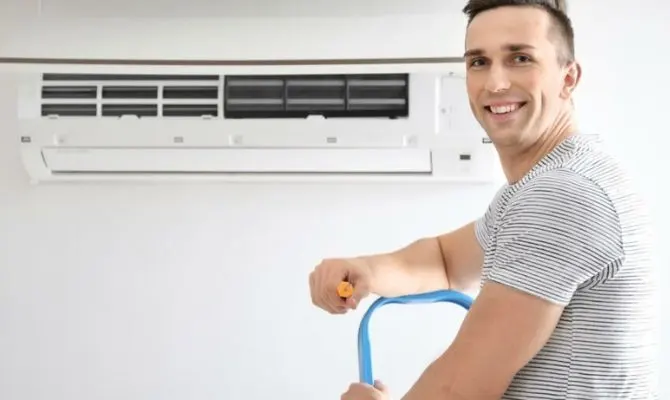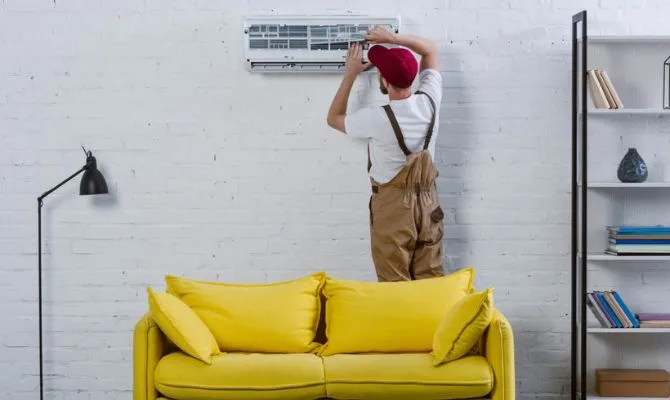Most of us are aware how conventional North American central air HVAC systems work. Basically, they depend on supply and return ductwork to deliver air between indoor and outdoor units.
That’s cool, but this method isn’t applicable to all homes and buildings. Some older homes and offices don’t have ductwork, and installing it would necessitate expensive and disruptive retrofitting. Floors and walls would have to be cut in order to install ducts. Fortunately, there is another way: Ductless air conditioner systems circulate the air indoors without the need for ductwork.
How Does a Ductless Split Air Conditioner Work?
Like conventional HVAC systems, ductless (or split) systems have two main components: an outdoor compressor/condenser and an indoor air-handling unit. The indoor and outdoor units are linked by a conduit, which contains the power cable, refrigerant tubing, suction tubing and condensate drain.
The ductless system transports air through the indoor air-handling unit to the outdoor unit, or condenser, through a series of pipes, where it comes into contact with coils containing a refrigerant. When the hot air inside the room comes into contact with these coils, the heat turns the refrigerant liquid inside into gas, which is sent to the compressor, where it is recycled back into a liquid. The newly cooled air then goes into the air-handler and goes back into the room.
This is repeated until the air in the room is cooled. There is no need for ducts or any connection to a furnace unit, unlike conventional systems. In a ductless system, individual indoor units are located in each room, so the cooling needs of each room can be handled and controlled as needed.
What Are the Different Types of Mini Split Air Conditioners?
Multi-zone mini splits are designed to control separate areas for heating and cooling. Their condenser can accommodate multiple air-handlers.
Dual-zone mini splits feature one condenser and two air-handlers. These are ideal for a home where the temperature needs to be regulated in multiple rooms.
Note that when installing these systems, you choose the correct BTU capacity for each room. The larger the room, the more BTUs per hour you’ll need.
Consult with your HVAC installation professional to choose the type of system that is appropriate for your needs.
Advantages vs. Conventional HVAC Systems
ENVIRONMENTALLY FRIENDLY
Ducts are subject to air leakage, which force air conditioning and heating units to work harder, thereby using more energy than ductless systems. Ductless systems use invertor technology, which requires lower energy to control the speed of the compressor motor – another energy saving.
COST SAVINGS
Ductless systems can also target specific rooms or areas within a home or building, delivering heating and cooling only where it is needed. As always, energy savings = cost savings. Check with your local government’s green programs, as tax rebates may be available for using energy-efficient systems.
IMPROVED AIR QUALITY
Conventional ducted systems can blow pollutants and allergens into the air, and they need to be cleaned and maintained regularly. Modern ductless systems, however, are equipped with filtration cartridges which help eliminate these airborne particles. Cartridges can be washed or replaced easily.
EASE OF INSTALLATION
Ductless systems can be installed quickly and cleanly, with little need to disrupt or rebuild walls or floors. Installation incurs minimal to no structural impact – another cost saving. They are also ideal for upgrading older buildings or in additions to existing structures, such as sunrooms, basements and attics.
VERSATILITY
A variety of orientations are available; you choose according to the configuration of your space: floor-mount, ceiling-recessed and horizontal styles are all available. These indoor units are inconspicuous and won’t distract from the aesthetics of your room.
QUIET
Ductless systems have a lower noise level than conventional HVAC systems; they’re ideal for all rooms, but particularly bedrooms and nurseries.
So, you don’t have all your ducts in a row? No problem. Ductless may be the way to go!



